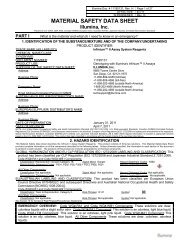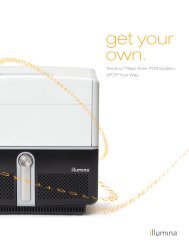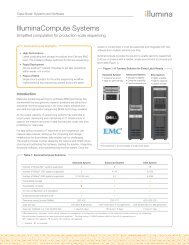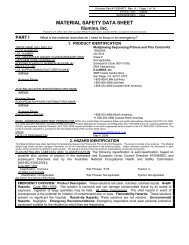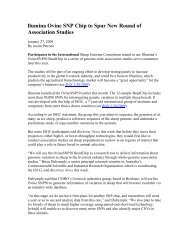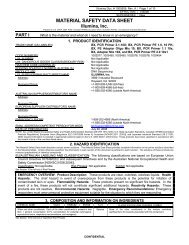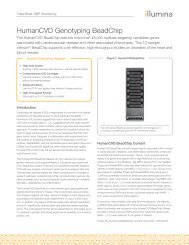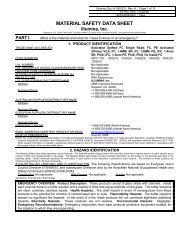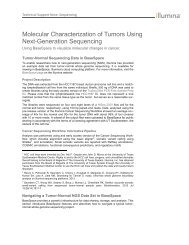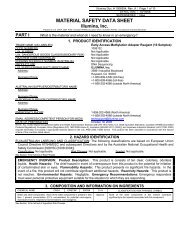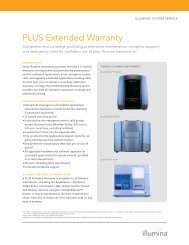Eco Real-Time PCR System Data Sheet - Illumina
Eco Real-Time PCR System Data Sheet - Illumina
Eco Real-Time PCR System Data Sheet - Illumina
You also want an ePaper? Increase the reach of your titles
YUMPU automatically turns print PDFs into web optimized ePapers that Google loves.
<strong>Data</strong> <strong>Sheet</strong>: <strong>Real</strong>-<strong>Time</strong> <strong>PCR</strong><br />
<strong>Eco</strong> <strong>Real</strong>-<strong>Time</strong> <strong>PCR</strong> <strong>System</strong><br />
The <strong>Real</strong>-<strong>Time</strong> <strong>PCR</strong> performance you expect in an easy-to-use, affordable, personal instrument.<br />
<strong>Eco</strong> <strong>Real</strong>-<strong>Time</strong> <strong>PCR</strong> <strong>System</strong> Highlights<br />
• Superior q<strong>PCR</strong> Performance<br />
Sensitivity down to 1 copy; dynamic range > 9 logs; discriminate<br />
between 5,000 and 10,000 copies with 99%+ confidence<br />
• Easy-to-Use Instrument<br />
Simple workflow and intuitive software<br />
• Most Affordable <strong>System</strong> Available<br />
Priced for the individual researcher<br />
<strong>Real</strong>-<strong>Time</strong> <strong>PCR</strong> for Everyone<br />
The <strong>Eco</strong> <strong>Real</strong>-<strong>Time</strong> <strong>PCR</strong> system puts powerful q<strong>PCR</strong> applications<br />
within reach of individual researchers. Large, expensive thermal cyclers<br />
that take up an entire workspace are replaced with an affordable,<br />
compact system that fits easily on any lab bench (Figure 1). Delivering<br />
unsurpassed data quality in less than 40 minutes for 40-cycle runs,<br />
the <strong>Eco</strong> system revolutionizes q<strong>PCR</strong> accessibility for both new and<br />
experienced <strong>Real</strong>-<strong>Time</strong> <strong>PCR</strong> users.<br />
The flexible <strong>Eco</strong> platform supports all chemistries and <strong>Real</strong>-<strong>Time</strong> <strong>PCR</strong><br />
applications, including absolute quantification by standard curve,<br />
relative quantification using the ΔΔCq method with support for multiple<br />
reference gene normalization, allelic discrimination by end-point<br />
fluorescence, and genotyping by High Resolution Melt (HRM) curve<br />
analysis. Whatever your q<strong>PCR</strong> needs are, the <strong>Eco</strong> system meets them.<br />
Breakthrough Instrument Design<br />
Developed through a collaboration between the labs of Nobel Laureate<br />
David Baltimore, Ph.D., and Axel Scherer, Ph.D., at the California<br />
Institute of Technology, the <strong>Eco</strong> system supports a range of demanding<br />
<strong>Real</strong>-<strong>Time</strong> <strong>PCR</strong> applications. The innovative instrument design (Figure<br />
2) includes an advanced thermal system for precise temperature<br />
control and a sensitive optical system that supports a wide variety<br />
of chemistries and fluorophores, providing researchers with a<br />
breakthrough user experience and unmatched cost-effectiveness.<br />
Unrivaled Temperature Control<br />
q<strong>PCR</strong> specificity and efficiency depend upon precise temperature<br />
control during the annealing and extension steps. For the highest<br />
accuracy, the temperature must remain uniform across the entire<br />
heat block, ensuring that all samples proceed equally through the<br />
<strong>PCR</strong> reaction. Most thermocyclers demonstrate a ± 0.5°C variation<br />
in temperature across their heat blocks, potentially leading to<br />
inaccurate results. In addition, they can take up to 15 seconds to reach<br />
temperature equilibrium at any given step across all wells, increasing<br />
the time to complete a q<strong>PCR</strong> run. The <strong>Eco</strong> <strong>Real</strong>-<strong>Time</strong> <strong>PCR</strong> system<br />
(Figure 2)overcomes these shortcomings with a proprietary thermal<br />
system that provides accurate temperature control and quickly cycles<br />
from one temperature to the next.<br />
To achieve this level of true temperature control, the <strong>Eco</strong> thermal<br />
system incorporates a precisely electroformed hollow silver block that<br />
is heated and cooled by a single Peltier device. The hermetically sealed<br />
hollow block contains a conductive fluid and two opposing agitators<br />
driven by electromagnetic motors. During <strong>PCR</strong> cycling, these agitators<br />
rapidly circulate the fluid throughout the hollow block, transferring heat<br />
from the Peltier device quickly and evenly across the block. This unique<br />
design virtually eliminates thermal non-uniformity and prevents “edge<br />
effects”, providing a new level of thermal performance below ± 0.1°C<br />
well-to-well uniformity across the 48-well plate (Table 1). The result:<br />
higher q<strong>PCR</strong> performance (tighter Cq, greater <strong>PCR</strong> efficiency, higher<br />
R 2 ) and the ability to perform demanding applications such as HRM.<br />
In addition, this unique thermal block design facilitates an average<br />
thermal ramp rate to 5.5°C / sec., reducing overall <strong>PCR</strong> run times.<br />
Typical run time for a 40-cycle <strong>PCR</strong> protocol is < 40 minutes.<br />
Precise, Sensitive Optical <strong>System</strong><br />
The <strong>Eco</strong> <strong>Real</strong>-<strong>Time</strong> <strong>PCR</strong> system contains an advanced highperformance<br />
optical system that delivers precise and sensitive<br />
Figure 1: <strong>Eco</strong> <strong>Real</strong>-<strong>Time</strong> <strong>PCR</strong> <strong>System</strong><br />
Simple Installation<br />
The benchtop <strong>Eco</strong> system is ready to use upon receipt. With a plugand-play<br />
design, instrument installation by experienced or novice<br />
scientists is quick and easy. No calibration is required.<br />
Optimized Sample Number<br />
To provide a small, benchtop-friendly, 13.6” × 12.2” footprint, the <strong>Eco</strong><br />
system employs an optimized 48-well plate format . For applications<br />
that require analysis of higher sample numbers, such as Standard Curve<br />
and Relative Quanitification studies, <strong>Illumina</strong> offers <strong>Eco</strong>Study software.<br />
<strong>Eco</strong>Study enables data from multiple plates to be combined and<br />
analyzed as a single study, effectively increasing sample throughput.<br />
Key components of the high-performance <strong>Eco</strong> <strong>Real</strong>-<strong>Time</strong> <strong>PCR</strong><br />
system include the <strong>Eco</strong> instrument, a notebook with <strong>Eco</strong> software<br />
pre-installed, and the <strong>Eco</strong> sample loading dock.
<strong>Data</strong> <strong>Sheet</strong>: <strong>Real</strong>-<strong>Time</strong> <strong>PCR</strong><br />
Figure 2: <strong>Eco</strong> <strong>Real</strong>-<strong>Time</strong> <strong>PCR</strong> <strong>System</strong> Innovative Design Features<br />
Intuitive icons lead researchers through<br />
setup, run, and analysis quickly and easily.<br />
Sensitive optical<br />
system delivers<br />
precise detection<br />
for a range of<br />
fluorophores.<br />
Convenient 48-well<br />
format meets the<br />
throughput needs of<br />
most researchers.<br />
Unique thermal system<br />
provides unmatched<br />
temperature control<br />
for the most accurate<br />
results.<br />
The <strong>Eco</strong> <strong>Real</strong>-<strong>Time</strong> <strong>PCR</strong> system offers the q<strong>PCR</strong> capabilities of larger instruments in a compact footprint. Innovative features include a precise<br />
thermal system for unrivaled temperature control, an advanced optical system for highly sensitive fluoresence detection, a 48-well plate for<br />
flexible sample throughput, and intuitive, icon-driven software for error-free instrument operation.<br />
fluorescence detection, facilitating all four-color multiplex applications.<br />
The system is provided factory-calibrated for use with SYBR, FAM,<br />
HEX, VIC, ROX, and Cy5, but can be used with any <strong>Real</strong>-<strong>Time</strong> <strong>PCR</strong><br />
fluorophores overlapping spectra with the calibrated dyes (Table 2).<br />
For excitation, two panels—48 fixed LEDs each—provide excitation<br />
energy of a distinct spectra, enabling excitation over a broad range of<br />
fluorophores. Each of the 48 LEDs illuminates a specific well location<br />
within the plate, eliminating the optical distortion created by most<br />
stationary optical systems.<br />
The optical system enables real-time detection of up to four targets<br />
in a single reaction. Four emission filters in a linear filter slide and a<br />
high-performance CCD camera detect the fluorescence from each<br />
well at each cycle (Figure 2). This approach prevents data loss and<br />
allows changes to plate setup and data analysis even after the run is<br />
completed. Standard melt curve and HRM analysis protocols are<br />
supported by continuous data acquisition in a single dye channel<br />
during the melt for increased data collection and reduced run times.<br />
User-Friendly Software<br />
A notebook computer pre-installed with flexible, easy-to-use software<br />
that integrates user control, real-time data collection, and advanced<br />
data analysis is provided with the <strong>Eco</strong> system. The software conforms<br />
to MIQE (Minimum Information for Publication of Quantitative <strong>Real</strong>-<strong>Time</strong><br />
<strong>PCR</strong> Experiments) guidelines*, making data analysis and submission<br />
for publication review more efficient.<br />
Easy-to-Use Interface<br />
<strong>Eco</strong> software uses a unique icon-driven user interface to simplify<br />
experimental design and setup (Figure 3). Pre-set thermal profile<br />
defaults are provided for the most commonly used experimental<br />
protocols. Temperature and time for each protocol step can easily<br />
be changed by click-and-drag action with the mouse. Experiment<br />
templates can be customized and saved for future use.<br />
* Bustin SA, Benes V, Garsong JA, Hellemans J, Hugget J, et al. (2009) The MIQE Guidelines: Minimum Information for Publication of Quantitative <strong>Real</strong>-<strong>Time</strong> <strong>PCR</strong><br />
Experiments. Clinical Chemistry 55:4.
<strong>Data</strong> <strong>Sheet</strong>: <strong>Real</strong>-<strong>Time</strong> <strong>PCR</strong><br />
Table 1: The <strong>Eco</strong> <strong>System</strong> Maintains Thermal Uniformity<br />
Over the Entire Plate for Better Cq Reproducibility<br />
Figure 3: Icon-Based Interface Easily Directs Users<br />
From Setup to Analysis<br />
Average<br />
Cq<br />
Standard<br />
Deviation<br />
of Cq<br />
Maximum<br />
Cq<br />
Minimum<br />
Cq<br />
24.131 0.063 24.339 24.017<br />
When running 48 replicates of a given assay, the <strong>Eco</strong> thermal<br />
system virtually eliminates the “edge effect” observed on other<br />
block-based q<strong>PCR</strong> instruments, leading to strong reproducibility of<br />
the replicates as shown by the extremely small standard deviation<br />
of the Cq.<br />
Table 2: <strong>Eco</strong> <strong>System</strong> Excitation and Emission Wavelengths<br />
Channel<br />
Excitation<br />
(nm)<br />
Emission<br />
(nm)<br />
Example Fluorophores<br />
Detected<br />
1 452–486 505–545 SYBR, FAM<br />
2 542 – 582 604–644 ROX<br />
3 452 – 486 562–596 HEX, VIC<br />
4 542–582 665–705 Cy5, Q670<br />
Two excitation LED arrays combined with four emission filters produce<br />
raw fluorescence data that are automatically analyzed using spectral<br />
deconvolution software to effectively minimize cross-talk between<br />
dyes. Additional dyes in the wavelength range of the optical system<br />
emission filters are supported with no additional calibration required.<br />
Intuitive icons on each screen enable researchers to easily walk<br />
through setup, run, and analysis for their <strong>Real</strong>-<strong>Time</strong> <strong>PCR</strong> experiment.<br />
Figure 4: Simplified <strong>Eco</strong> <strong>System</strong> Workflow<br />
1. Load samples<br />
in plate using<br />
the convenient<br />
<strong>Eco</strong> sample<br />
loading dock.<br />
<strong>Data</strong> Analysis<br />
With the <strong>Eco</strong> system and software, data collection is monitored in<br />
real time, allowing researchers to access run viability immediately.<br />
The user-friendly data analysis interface allows researchers to easily<br />
view the component data, amplification plot, melt curve analysis, and<br />
the analyzed results, including Cq values, standard curve equations,<br />
RQ values, and genotyping calls. <strong>Data</strong> can be exported into Excel or<br />
CSV and custom reports generated directly into PowerPoint or PDF<br />
formats. High-resolution images can be directly exported in multiple<br />
image formats, ready to use in any presentation.<br />
2. Place sample<br />
plate in instrument.<br />
Increased Throughput<br />
<strong>Eco</strong>Study software allows mulitple <strong>PCR</strong> runs to be combined and<br />
analyzed as a single study, effectively increasing the <strong>Eco</strong> system’s<br />
sample throughput. One standard curve is applied across all the plates<br />
so that only one, the “mother plate”, needs to dedicate multiple wells<br />
to reference standards. All additional plates or “daughter plates”, are<br />
compared against the standard curve generated on the mother plate.<br />
This eliminates the need for each plate to carry its own standards,<br />
making wells available for samples and increasing throughput.<br />
Simplified Workflow<br />
The <strong>Eco</strong> workflow is based on three simple steps: load samples into<br />
the 48-well plate, place the plate into the <strong>Eco</strong> instrument, and run<br />
(Figure 4). The <strong>Eco</strong> software provides instrument control, data<br />
collection, and data analysis. The most common q<strong>PCR</strong> parameters<br />
are automatically in place. These can be easily changed on the<br />
computer to meet specific experimental requirements.<br />
3. Run—intuitive<br />
software takes<br />
care of the rest,<br />
including data<br />
analysis.
<strong>Data</strong> <strong>Sheet</strong>: <strong>Real</strong>-<strong>Time</strong> <strong>PCR</strong><br />
Figure 5: Highly Accurate q<strong>PCR</strong> Results<br />
<strong>Eco</strong> <strong>System</strong> Specifications<br />
Results obtained from a standard q<strong>PCR</strong> run using the <strong>Eco</strong> evaluation<br />
plate. The experiment was performed in a 20-µl final reaction volume<br />
with SYBR Green Master Mix. <strong>PCR</strong> efficiency is 100% with R 2 = 0.996.<br />
The 24 unknown samples were quantified with a Standard Deviation<br />
of Cq = 0.09. These measurements indicate great data quality.<br />
High-Performance Results<br />
Due to unmatched temperature control and an optical system<br />
designed for individual well monitoring, the <strong>Eco</strong> system produces<br />
highly accurate, reliable results with <strong>PCR</strong> efficiencies between 90%<br />
and 110% and R 2 > 0.99 when using standard optimized assays<br />
(Figure 5).<br />
Accessible q<strong>PCR</strong><br />
With the <strong>Eco</strong> <strong>Real</strong>-<strong>Time</strong> <strong>PCR</strong> system, highly accurate q<strong>PCR</strong> results<br />
can be easily obtained on any budget. Combining precise<br />
temperature control, four-color multiplex capabilities, an optimized<br />
optical system, and intuitive software in a small-footprint device,<br />
the affordable <strong>Eco</strong> system is available to all researchers. Now everyone<br />
can own their own q<strong>PCR</strong> instrument; ready for use when they are,<br />
leading to more productive and successful research.<br />
Learn more<br />
For more information about the <strong>Eco</strong> <strong>Real</strong>-<strong>Time</strong> <strong>PCR</strong> system, visit<br />
www.illumina.com/ecoqpcr.<br />
<strong>Eco</strong> <strong>System</strong> and Accessories<br />
Product Quantity Catalog No.<br />
<strong>Eco</strong> <strong>Real</strong>-<strong>Time</strong> <strong>PCR</strong> <strong>System</strong><br />
(110 V or 220V)<br />
1 unit EC-101-1001<br />
<strong>Eco</strong> loading dock 1 unit EC-200-1001<br />
<strong>Eco</strong> plates 40 plates EC-200-1002<br />
<strong>Eco</strong> adhesive seals 40 seals EC-200-1003<br />
Catalog No. EC-101-1001<br />
Instrument<br />
Thermal system: Proprietary hollow silver block with Peltier-based<br />
system<br />
Block format: 48-well block<br />
Consumables: 48-well custom plates and optical adhesive seals<br />
Sample volumes: Validated for 5–20 µl<br />
Average ramp rate: 5.5°C/sec<br />
Temperature range: 40–100°C<br />
Temperature uniformity: ± 0.1°C<br />
Optical system: Dual LED excitation (452–486 nm and 542–582 nm),<br />
four emission filters (505–545 nm, 562–596 nm, 604–644 nm, and<br />
665–705 nm) and CCD camera<br />
Calibrated dyes at shipment: SYBR Green, FAM, HEX, ROX, Cy5,<br />
and Q670. Additional dyes within the wavelength range compatible<br />
with <strong>Eco</strong> filters are supported with no additional calibration required<br />
for implementation<br />
Passive reference dyes: Use of ROX is supported, but optional<br />
<strong>Data</strong> collection: <strong>Data</strong> collected in all four filters for all wells regardless<br />
of plate setup; plate setup for data analysis can be altered after run<br />
completion<br />
Melt curve analysis supports continuous data acquisition in a single<br />
filter to provide increased data point collection and reduced run<br />
times<br />
<strong>Real</strong>-<strong>Time</strong> <strong>PCR</strong> run time (40 cycles): Less than 40 minutes<br />
12-month service contract, including parts and labor<br />
Electrical<br />
Voltage: 120–240 VAC = 10%<br />
Frequency: 50/60 Hz = 1%<br />
Nominal current draw: 8A<br />
Peak power: 500W; typical power is 180W<br />
Software<br />
Multiple-license <strong>Eco</strong> system software is included at no additional<br />
cost; virtually all chemistries supported; applications include<br />
Absolute Quantification, Relative Quantification, Allelic Discrimination,<br />
High Resolution Melt curve analysis (HRM)<br />
Dimensions<br />
Closed W×D×H: 13.6 in × 12.2 in × 12.6 in<br />
Open W×D×H: 13.6 in × 12.2 in × 14.5 in<br />
Weight: 13.6 Kg (30 lbs)<br />
Performance<br />
Sensitivity: 1 copy<br />
Dynamic range: > 9 logs linear range<br />
Precision: Discriminates 5,000 and 10,000 template copies with 99%<br />
confidence<br />
<strong>Illumina</strong> • 1.800.809.4566 toll-free (U.S.) • +1.858.202.4566 tel • techsupport@illumina.com • www.illumina.com<br />
For research use only<br />
© 2012, 2013 <strong>Illumina</strong>, Inc. All rights reserved.<br />
<strong>Illumina</strong>, illuminaDx, BaseSpace, BeadArray, BeadXpress, cBot, CSPro, DASL, DesignStudio, <strong>Eco</strong>, GAIIx, Genetic Energy,<br />
Genome Analyzer, GenomeStudio, GoldenGate, HiScan, HiSeq, Infinium, iSelect, MiSeq, Nextera, Nu<strong>PCR</strong>, SeqMonitor, Solexa,<br />
TruSeq, TruSight, VeraCode, the pumpkin orange color, and the Genetic Energy streaming bases design are trademarks or registered<br />
trademarks of <strong>Illumina</strong>, Inc. All other brands and names contained herein are the property of their respective owners.<br />
Pub. No. 570-2010-011 Current as of 11 March 2013



